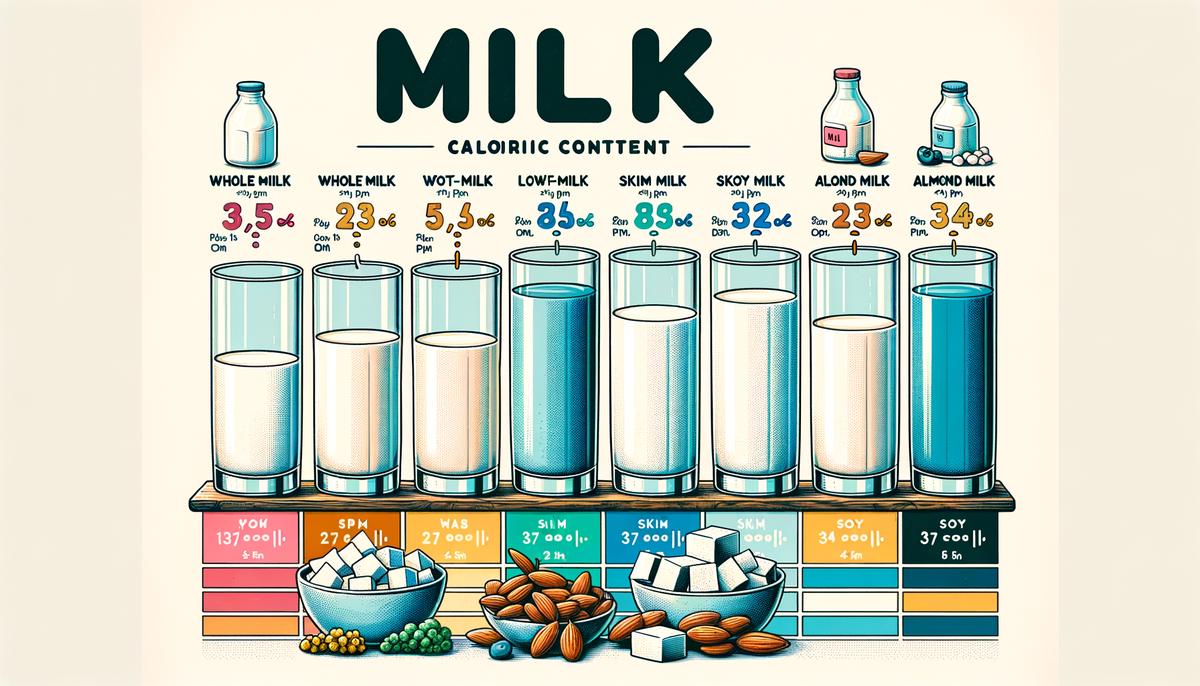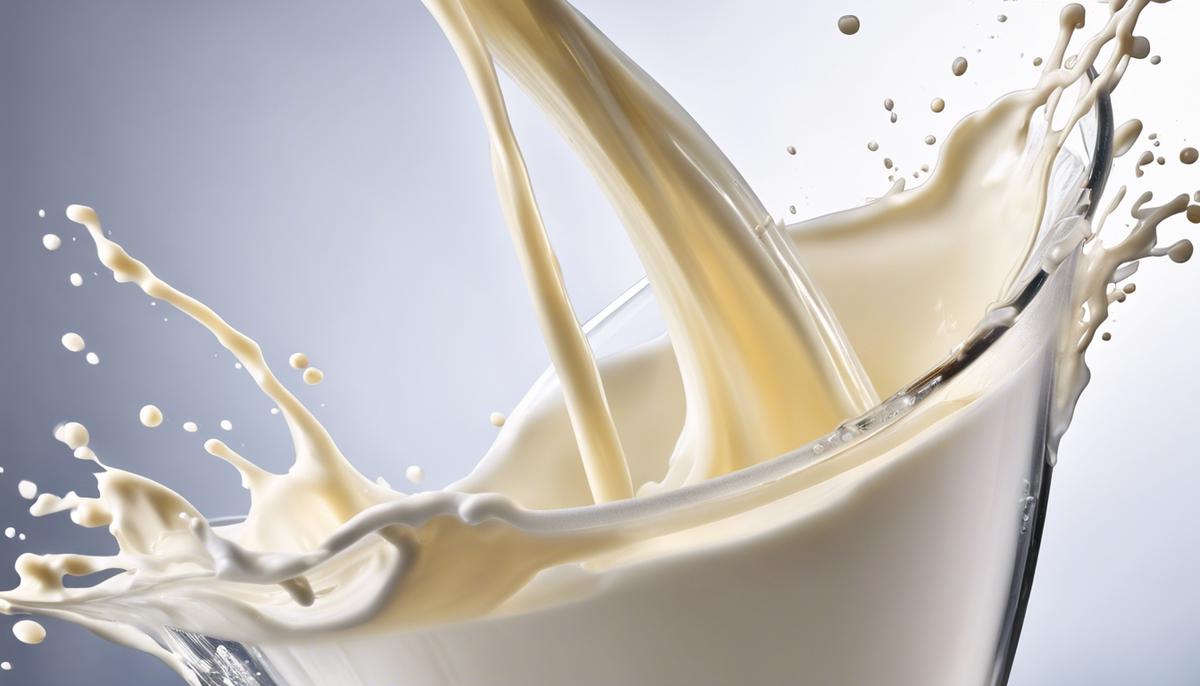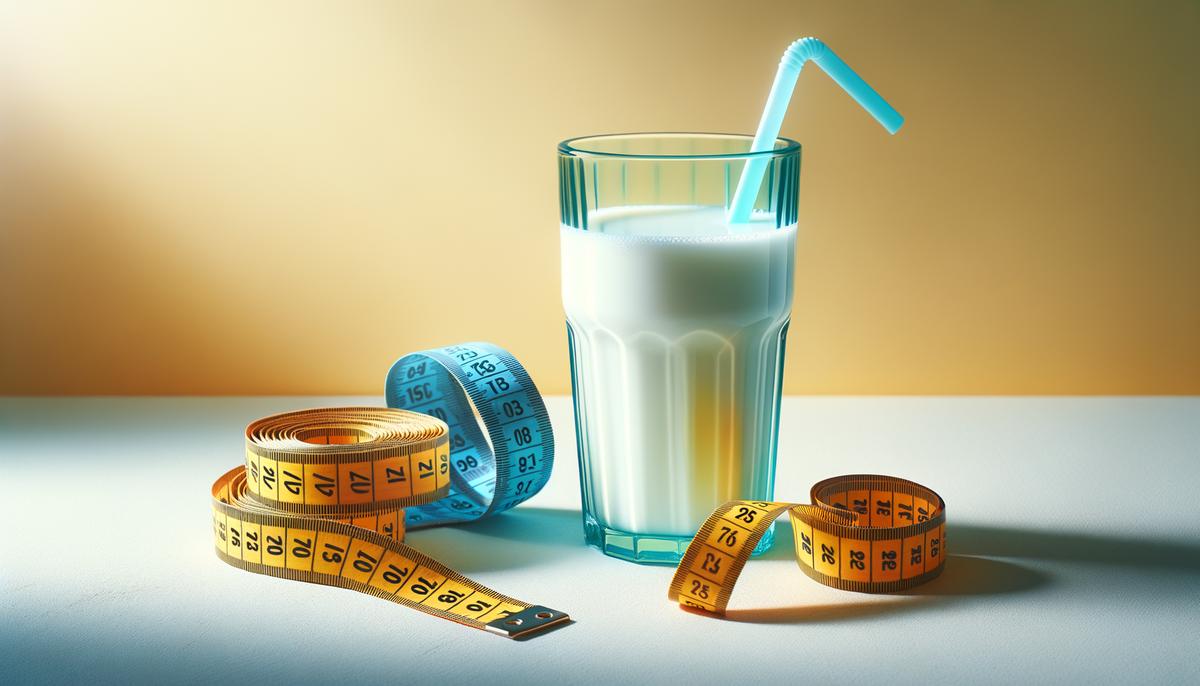Skim milk has become a topic of interest for those looking to improve their health and understand their dietary choices better. This article aims to shed light on what skim milk is, its nutritional value, and the health benefits it may offer. By exploring its role in a balanced diet and comparing it with other milk types, we aim to provide a clear understanding of how skim milk fits into a health-conscious lifestyle.
Table of Contents
- 1 Understanding Skim Milk
- 1.1 Understanding Skim Milk
- 1.2 Nutritional Profile of Skim Milk
- 1.3 Benefits of Choosing Skim Milk
- 1.4 Comparisons with Other Milk Types
- 1.5 Environmental and Ethical Considerations
- 1.6 Nutritional Strategies and Recommendations
- 1.7 Expert Views
- 1.8 The Role of Skim Milk in Dietary Patterns
- 1.9 FAQ Section
- 2 Caloric Comparison
- 2.1 Calories in Skim Milk vs. Other Milks: A Detailed Examination
- 2.2 Whole Milk: The Caloric Comparison
- 2.3 2% Milk: A Middle Ground
- 2.4 Almond Milk: A Low-Calorie Plant-Based Option
- 2.5 Soy Milk: Nutrient-Rich and Moderate Calories
- 2.6 Oat Milk: Calorie Content in the Spotlight
- 2.7 Caloric Impact and Dietary Choices
- 2.8 Skim Milk in a Balanced Diet
- 2.9 In Summary
- 3 Health Implications
- 4 Nutritional Profile and Benefits
Understanding Skim Milk
Title: What Exactly is Skim Milk? Understanding its Nutritional Value and Health Benefits
What is skim milk? This question surfaces frequently among individuals aiming to make healthier dietary choices. Skim milk, often regarded as a staple in low-fat diets, offers a unique composition that sets it apart from its whole and reduced-fat counterparts. In this article, we navigate through the specifics of skim milk, from its production process to its place in a balanced diet, providing a clear picture for those looking to understand its nutritional profile and health implications.
Understanding Skim Milk
Skim milk, also known as nonfat or fat-free milk, undergoes a process to remove virtually all the fat content. This results in a product that retains most of the essential nutrients found in milk but with significantly reduced fat and calorie content.
Key Points:
- Skim Milk: Essentially fat-free, with no more than 0.5% milk fat.
- Retains essential nutrients like calcium, vitamin D, and protein.
- Offers a low-calorie option for those monitoring their calorie intake.
Nutritional Profile of Skim Milk
Despite the removal of fat, skim milk remains a nutritious beverage:
Protein: Approximately 8 grams per cup, vital for muscle repair and growth.
Calcium: Essential for bone health, a cup of skim milk provides about 300 milligrams.
Vitamins: Fortified with vitamin D and rich in vitamin B12, supporting bone health and energy production.
Benefits of Choosing Skim Milk
Selecting skim milk can offer several advantages, particularly for those focused on specific health goals:
- Lower Calorie Intake: With fewer calories than whole milk, skim milk can fit into a calorie-controlled diet effectively.
- Heart Health: The minimal fat content helps manage cholesterol levels, potentially benefiting heart health.
- Supports Weight Management: The lower calorie and fat content, coupled with high protein, can aid in weight management efforts.
Comparisons with Other Milk Types
When weighed against whole and 2% milk, skim milk stands out for its lower fat and calorie content:
- Whole Milk: Contains about 8 grams of fat and 150 calories per cup.
- 2% Milk (Reduced Fat): Offers around 5 grams of fat and 120 calories per cup.
- Skim Milk: Virtually fat-free with approximately 80 calories per cup.
Environmental and Ethical Considerations
The process of producing skim milk involves separating the fat from the milk, which can raise questions about sustainability and ethical practices in the dairy industry. It’s vital to consider the sourcing of skim milk, opting for products from farms that prioritize animal welfare and sustainable practices.
Nutritional Strategies and Recommendations
Incorporating skim milk into your diet can be straightforward and versatile:
- Enjoy it as a drink, either cold or warm.
- Use it in cereal or oatmeal for a nutritious breakfast.
- Substitute it for whole milk in recipes to reduce fat without sacrificing moisture.
Expert Views
Nutrition professionals often highlight skim milk’s role in a balanced diet:
- Registered Dietitian’s Perspective: “Skim milk offers a way to enjoy the nutritional benefits of milk while limiting intake of saturated fat and calories, making it a suitable choice for many health-conscious individuals.”
The Role of Skim Milk in Dietary Patterns
While skim milk presents several nutritional benefits, it’s one component of a varied and balanced diet. Its consumption should align with individual health needs and dietary preferences. Some may prefer the richer taste and additional calories of whole milk, while others may select skim milk for its lower fat and calorie content.
FAQ Section
Q: Is skim milk a good source of protein?
A: Yes, skim milk provides a significant amount of protein, making it a great option for muscle maintenance and repair.
Q: Can skim milk help with weight loss?
A: Skim milk can be a part of a weight-loss diet due to its low calorie and fat content, but overall dietary and exercise habits are also crucial.
Q: Does skim milk provide enough calcium?
A: Absolutely, skim milk offers a rich source of calcium, vital for bone health, in amounts comparable to whole milk.
Understanding skim milk’s role in nutrition and health enables informed dietary choices. By considering its reduced fat and calorie content alongside maintained essential nutrients, skim milk can be a valuable part of a health-focused diet, adaptable to various culinary uses and suitable for a range of dietary requirements.

Caloric Comparison
Calories in Skim Milk vs. Other Milks: A Detailed Examination
When considering milk options, one of the significant comparisons people make revolves around caloric content. Skim milk, known for its reduced fat content, sits on one end of the spectrum. Let’s delve into how its caloric content stacks up against whole milk, 2% milk, and plant-based alternatives like almond, soy, and oat milk.
Whole Milk: The Caloric Comparison
Whole Milk traditionally has been a staple in many diets, prized for its rich texture and flavor. A 240 ml (8 oz) serving contains approximately 150 calories. This higher calorie count reflects its fuller fat content, which contributes to its creamy consistency.2% Milk: A Middle Ground
2% Milk, often termed reduced-fat milk, offers a compromise between whole milk and skim milk. For every 240 ml (8 oz) serving, it provides roughly 120 to 130 calories, bridging the gap for those seeking lower fat content without fully transitioning to skim milk.Almond Milk: A Low-Calorie Plant-Based Option
Almond Milk stands out among plant-based milks for its notably lower calorie count. An unsweetened 240 ml (8 oz) serving contains about 30 to 50 calories. This significant decrease is due to the milk’s lower fat content and the absence of lactose, making it a popular choice for calorie-conscious individuals.Soy Milk: Nutrient-Rich and Moderate Calories
Soy Milk, a staple in plant-based diets, offers a closer nutritional profile to cow’s milk. A standard 240 ml (8 oz) serving holds around 80 to 90 calories. Its balanced mix of protein, vitamins, and minerals, along with moderate caloric content, makes it a favored option for those seeking dairy alternatives.Oat Milk: Calorie Content in the Spotlight
Oat Milk has gained popularity for its smooth texture and environmental benefits. Calorically, it sits higher than almond and soy milk, with a 240 ml (8 oz) serving providing approximately 120 to 130 calories, similar to 2% cow’s milk. Its composition, which includes oats and oil for creaminess, accounts for the higher calorie count.Caloric Impact and Dietary Choices
Choosing between skim, whole, and other milk varieties often comes down to dietary goals and nutritional needs. Skim milk, with about 80 calories per 240 ml (8 oz) serving, offers a low-calorie option for those managing their caloric intake. However, it’s essential to consider the broader nutritional picture, including protein, calcium, and vitamin needs, when making milk choices.
Skim Milk in a Balanced Diet
Incorporating skim milk into your diet can be a strategic way to reduce caloric intake while still benefiting from milk’s nutritional offerings, such as high-quality protein and calcium. It serves well as a base for smoothies, in cereal, or simply as a refreshing drink, providing versatility without adding excessive calories.
In Summary
Comparing skim milk to other milk types reveals a spectrum of caloric contents, from the low-calorie plant-based almond milk to the richer, full-fat whole milk. Each type brings unique nutritional benefits and considerations, making it important to align milk choice with individual health goals and dietary preferences. Remember, the best choice is one that fits seamlessly into your lifestyle, offering both nutritional benefits and enjoyment.

Health Implications
Is Skim Milk Truly the Healthier Choice?
In exploring whether skim milk stands as the healthier choice among various milk options, we delve into its role within dietary frameworks beyond the straightforward calorie and fat content comparison. Skim milk, often praised for its lower fat content, garners attention from those aiming to reduce calorie intake or manage weight efficiently. However, the broader implications of choosing skim milk, including its nutritional balance, impact on satiety, and overall health contribution, require a closer look to guide informed dietary decisions.
Satiety and Nutritional Quality
One critical aspect of skim milk involves its impact on satiety levels. With the fat removed, skim milk is lower in calories compared to its whole and 2% counterparts. This reduction in fat content results in a quicker digestion process, potentially leading to increased hunger signals shortly after consumption. For individuals focusing on weight management, the balance between calorie intake and satiety becomes paramount. Including skim milk in a meal that features a combination of carbohydrates, proteins, and healthy fats may offset any rapid return of hunger, creating a more sustained feeling of fullness.
Nutrient Absorption and Health Benefits
The removal of fat from milk raises questions about the absorption of fat-soluble vitamins, such as Vitamins A, D, E, and K. Skim milk is often fortified with Vitamins A and D to compensate for this loss; however, the bioavailability of these nutrients in the absence of dietary fat might be reduced. It suggests that while skim milk can contribute valuable nutrients to one’s diet, other food sources with natural fats or supplemental intake may be necessary to ensure optimal absorption of these fat-soluble vitamins.
Additionally, the health benefits associated with the consumption of certain fats found in whole milk, like conjugated linoleic acid (CLA) and omega-3 fatty acids, which are linked to reduced inflammation and improved heart health, are absent in skim milk. It points to a nuanced perspective on dietary fats, where the quality and context of fat consumption play critical roles in health outcomes.
Skim Milk and Bone Health
A common perception is that dairy consumption is essential for bone health due to its calcium content. While skim milk offers a low-calorie, nutrient-rich source of calcium, the complete picture also considers the role of fat in calcium absorption and bone density. Some studies suggest that dietary fat aids in the absorption of calcium, potentially impacting the efficacy of skim milk in supporting bone health. Nevertheless, the presence of other nutrients in skim milk, like protein and Vitamin D, supports its role in a diet aimed at maintaining bone density and overall health.
Lactose Intolerance and Dairy Sensitivities
For individuals with lactose intolerance or dairy sensitivities, the choice between skim and whole milk may come down to digestibility and personal tolerance levels. Skim milk contains similar levels of lactose as whole milk, meaning those with lactose intolerance should consider lactose-free options or plant-based alternatives regardless of the fat content. It highlights the importance of tailoring dairy choices to individual health needs and preferences, ensuring dietary selections promote well-being and comfort.
Personal Preferences and Lifestyle Considerations
Ultimately, the decision to incorporate skim milk into one’s diet hinges on personal preferences, dietary goals, and lifestyle considerations. Skim milk can be a valuable part of a balanced diet for those seeking to lower their intake of saturated fats or manage calorie consumption without sacrificing essential nutrients like calcium and protein. However, it’s vital to consider the broader dietary context, ensuring a varied and nutritious intake that supports overall health, satisfies taste preferences, and accommodates any dietary restrictions.
For individuals prioritizing weight management or monitoring heart health, skim milk presents a viable option when consumed as part of a diverse and balanced diet. Contrastingly, those focused on maximizing nutrient absorption or addressing dietary sensitivities may explore alternative milk options or adjust their diet to include a variety of nutrient sources. Engaging with healthcare professionals and nutritionists can provide personalized advice, tailoring dairy consumption to fit one’s health objectives and dietary needs effectively.
In reflecting on the role of skim milk within dietary patterns, it becomes clear that its health implications extend beyond a simple comparison of fat and calorie content. Considering factors such as satiety, nutrient absorption, and personal health goals is essential in determining whether skim milk is the healthier choice for an individual. As with any dietary decision, embracing flexibility and mindful consideration of the broader nutritional landscape ensures choices align with one’s health journey and lifestyle aspirations.

Nutritional Profile and Benefits
Skim Milk and Weight Management
One of the nutritional advantages of skim milk is its role in weight management. As a low-calorie option, it seamlessly fits into various diet plans aimed at maintaining or reducing weight. With only about 83 calories per cup (approximately 245 grams), compared to whole milk, which contains about 149 calories per same serving size, skim milk provides a considerable calorie reduction. This feature is especially beneficial for those looking to consume dairy without overloading on calories.
Protein Content and Muscle Maintenance
Skim milk is a high-quality protein source, offering about 8 grams per cup. This protein is not just any protein; it’s complete, meaning it contains all essential amino acids necessary for bodily functions, including muscle repair and growth. For individuals engaged in regular physical activity, incorporating skim milk into their diet can contribute to muscle maintenance and recovery after exercises, without the extra fat content found in whole milk.
Vitamins and Minerals Galore
Aside from its protein content, skim milk is fortified with vitamins A and D, making it a nutrient-packed beverage. Vitamin A is crucial for maintaining healthy vision, immune function, and skin health, while Vitamin D plays a significant role in bone health by enhancing calcium absorption in the gut. Moreover, skim milk provides a good source of calcium, potassium, and phosphorus — minerals essential for bone health, blood pressure regulation, and energy production, respectively.
Cardiovascular Health
The low-fat aspect of skim milk is particularly advantageous for heart health. By opting for skim milk over higher-fat milk options, individuals can decrease their intake of saturated fats, which are linked to higher cholesterol levels and an increased risk of heart disease. Skim milk thus offers a way to enjoy the benefits of dairy while still supporting heart health.
Hydration and Refreshment
Skim milk contains a high water content, making it an excellent option for staying hydrated. Unlike sugary beverages that can lead to a spike in blood sugar levels and subsequent crashes, skim milk provides steady energy. Its electrolytes, including potassium, help replenish the body’s needs, especially post-workout, making it a superior choice for athletes and active individuals.
Skim Milk and Diabetes
For individuals managing diabetes, skim milk presents a viable option due to its low fat and moderate carbohydrate content. The balance of protein and carbohydrates in skim milk can help maintain stable blood glucose levels, making it a smart choice for diabetics or those at risk of developing the condition. The presence of dietary calcium in skim milk also plays a role in metabolic processes that help regulate insulin sensitivity.
Practical Tips for Incorporating Skim Milk
Incorporating skim milk into one’s diet can be simple and versatile. It can be consumed directly as a refreshing beverage, blended into smoothies for added protein, or used in cooking and baking as a substitute for whole milk to reduce fat without sacrificing texture or taste. Skim milk also pairs well with whole grains in cereal, providing a balanced breakfast option that fuels the day’s activities.
Making Informed Choices
Selecting skim milk is more than just a dietary preference; it’s a conscious choice for health. While it offers numerous nutritional benefits, as with any food or drink, it’s important to consume it as part of a varied and balanced diet. Understanding one’s individual nutritional needs, possibly with the guidance of a healthcare provider, can help make skim milk a beneficial part of one’s dietary routine.
In the pursuit of a balanced diet, skim milk emerges as a valuable dairy option. Its reduced calorie content, coupled with a rich array of nutrients, supports weight management, muscle maintenance, cardiovascular health, and more. For those looking to enjoy the benefits of milk while minimizing fat intake, skim milk offers an admirable compromise, bridging the gap between nutritional value and dietary preferences.

As we have explored the various aspects of skim milk, from its nutritional profile to its benefits for weight management and heart health, it’s clear that skim milk can play a crucial role in a balanced diet. It offers a way for individuals to enjoy milk’s nutritional benefits while managing calorie and fat intake. Skim milk is more than just a low-fat option; it’s a choice that supports overall health and wellness. By considering individual health needs and dietary preferences, one can effectively incorporate skim milk into their eating habits, making informed decisions for a healthier lifestyle.

Tamara Tanasković Specialist Professional Nutritionist-Dietitian Expert in Public Health Nutrition
As an authoritative source in nutrition and dietetics, my website serves as a comprehensive educational platform. It offers in-depth insights into nutrition, covering diverse areas like dietetics, food technology, and specific nutritional needs during different life stages such as childhood, adolescence, pregnancy, and lactation. Additionally, I provide evidence-based clarifications on prevalent nutrition myths.
Visitors to the site can benefit from my expertise as a specialist professional nutritionist-dietitian through personal consultations or tailored nutrition plans designed to meet individual health goals.
Biography
Tamara Tanasković’s professional journey began with a foundational education at the Pharmaceutical-Physiotherapeutic School, where she specialized as a cosmetic technician and a physiotherapy technician. This multidisciplinary background laid the groundwork for her focused studies in nutrition and dietetics at the Higher School of Health Studies in Belgrade. Her advanced academic achievements earned her the title of a specialist nutritionist-dietitian, with a particular emphasis on public health.
I am the creator of the influential Instagram page @planishrane, dedicated to spreading knowledge about healthy eating habits, the importance of lifestyle choices, and the interplay between diet and various health conditions. My experience extends over several years in crafting personalized online meal plans, catering to both wellness-focused individuals and those with specific health conditions.
In collaboration with cosmetician Jelena Vještica, I co-authored four handbooks in January 2021. These guides delve into the relationship between diet and skin health, specifically addressing facial care and nutritional approaches to managing acne and related skin conditions.
My work and the impact of my website have garnered recognition from renowned entities like Prolom Water, Prolom Spa, Lukovska Spa, Just Superior, Jumbo, ABC, Fun&Fit, Piazza Organica, and more.
In line with my commitment to holistic health, I engage in the cultivation of organic herbs, vegetables, and fruits. My mission is to empower individuals with the knowledge and tools to make informed health choices throughout their lives, fostering a culture of wellness and informed dietary practices.
Embracing Healthy Eating for a Healthier Life!





